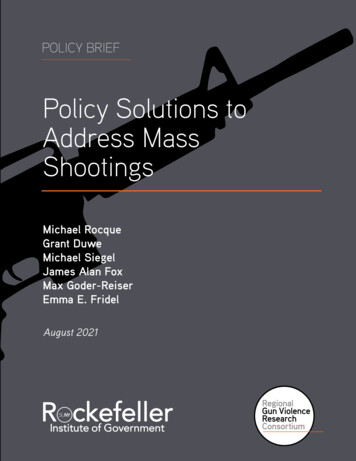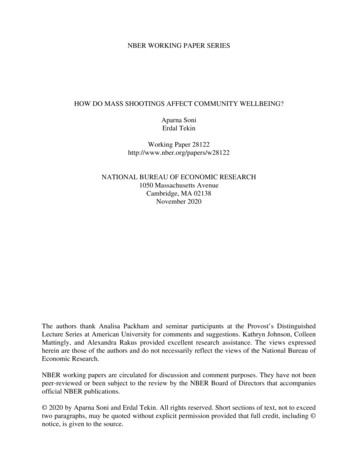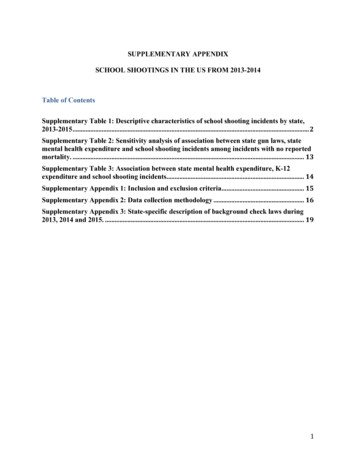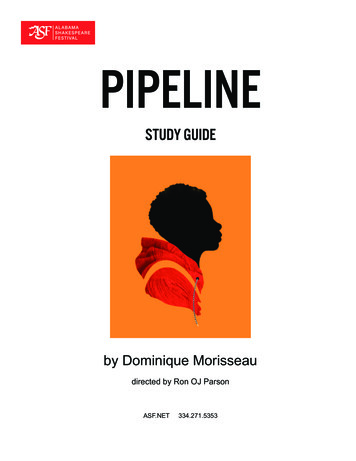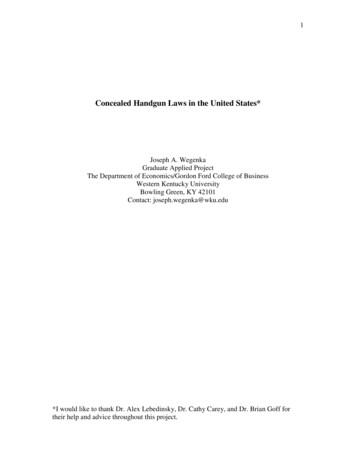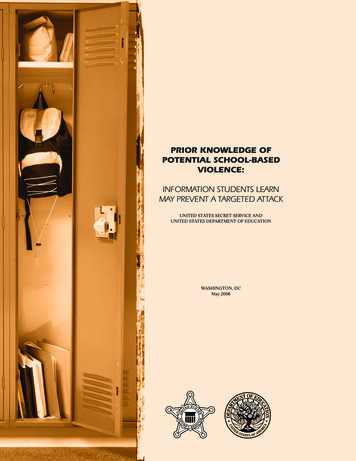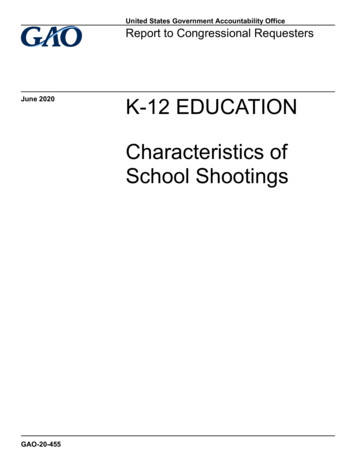
Transcription
United States Government Accountability OfficeReport to Congressional RequestersJune 2020K-12 EDUCATIONCharacteristics ofSchool ShootingsGAO-20-455
June 2020K-12 EDUCATIONCharacteristics of School ShootingsHighlights of GAO-20-455, a report tocongressional requestersWhy GAO Did This StudyWhat GAO FoundIn addition to the potential loss oflife, school shootings can evokefeelings of profound fear and anxietythat disturb a community’s sense ofsafety and security. Questions havebeen raised about whether schools’approaches to addressing studentbehavior are a factor in schoolshootings. These approachesinclude discipline that removes theoffending students from theclassroom or school, andpreventative approaches meant tochange student behaviors beforeproblems arise.GAO found that shootings at K-12 schools most commonly resulted fromdisputes or grievances, for example, between students or staff, orbetween gangs, although the specific characteristics of school shootingsover the past 10 years varied widely, according to GAO’s analysis of theNaval Postgraduate School’s K-12 School Shooting Database. (Seefigure.) After disputes and grievances, accidental shootings were mostcommon, followed closely by school-targeted shootings, such as those inParkland, Florida and Santa Fe, Texas.K-12 School Shootings by Kind, School Years 2009-10 through 2018-19GAO was asked to examine schoolshootings, including the link betweendiscipline and shootings. This reportexamines 1) the characteristics ofschool shootings and affectedschools, and 2) what is known aboutthe link between discipline andschool shootings. To do so, GAOanalyzed data on school shootingsand school characteristics for schoolyears 2009-10 through 2018-19; andconducted a literature review toidentify empirical research from2009 to 2019 that examineddiscipline approaches in school, andthe effects of these approaches onoutcomes of school gun violence,school violence, or school safety.GAO also interviewed selectedresearchers to gather perspectivesabout challenges and limitations inconducting research on schooldiscipline and school shootings.View GAO-20-455. For more information,contact Jacqueline M. Nowicki at (617) 7880580 or nowickij@gao.gov.The shooter in about half of school shootings was a student or former student; inthe other half, the shooter had no relationship to the school, was a parent,teacher, or staff, or his or her relationship to the school was unknown, accordingto the data. When the shooting was accidental, a suicide, or school-targeted, theshooter was more often a student or former student. However, when the shootingwas the result of a dispute or grievance, the shooter was someone other than astudent in the majority of cases. For about one-fifth of cases, the shooter’srelationship to the school was not known. (See figure.)United States Government Accountability Office
The characteristics of schools where shootingsoccurred over the past 10 years also varied bypoverty level and racial composition. Urban,poorer, and high minority schools had moreshootings overall, with more characterized as adispute or grievance. Suburban and rural,wealthier, and low minority schools had moresuicides and school-targeted shootings, whichhad the highest fatalities per incident. Overall,more than half of the 166 fatalities were theresult of school-targeted shootings.K-12 School Shootings by Shooter, School Years 2009-10 through 2018-19The location of the shootings more often tookplace outside the school building than insidethe school building, but shootings inside weremore deadly, according to the data. Shootingsresulting from disputes occurred more oftenoutside school buildings, whereas accidentsand school-targeted shootings occurred moreoften inside school buildings. (See figure.)GAO found no empirical research in the last 10years (2009-2019) that directly examined thelink between school discipline and schoolshootings. According to literature GAOexamined and five study authors GAOinterviewed, various factors contribute to thelack of research examining this particular link,including that multiple and complex factorsaffect an individual’s propensity towardviolence, making it difficult to isolate the effectof any one factor, including school discipline.Notes: Percentages do not add to 100 percent, due to rounding. “Unknown,” as recorded in the K12 School Shooting Database, includes incidents in which the shooter was identified but theshooter’s relationship to the school could not be determined. “Other” combines four categories fromthe K-12 School Shooting Database: intimate relationship with victim, multiple shooters, studentsfrom a rival school, and non-students using athletic facilities/attending game.K-12 School Shootings by Shooting Location and Kind of Shooting, School Years 2009-10 through 2018-19Notes: The location of one of the 318 incidents was unknown, and therefore, excluded from this analysis. As a result, the total incidents in this analysis is317. GAO combined three categories from the K-12 School Shooting Database into an “Outside the school building” category: outside on schoolproperty, off school property, and on school bus.
ContentsLetter1BackgroundCharacteristics of Shooting Incidents and Schools VariedEmpirical Research Does Not Directly Examine Link betweenDiscipline and School ShootingsAgency Comments4122630Appendix IObjectives, Scope, and Methodology31Appendix IIAdditional Data Tables and Figure44Appendix IIISummary and Table of Studies Included in Literature Review47Appendix IVGAO Contact and Staff Acknowledgments51TablesTable 1: Examples of Risk and Protective Factors That InfluenceYouth ViolenceTable 2: School Shootings and Fatalities/Casualties by Kind ofShooting, School Years 2009-10 through 2018-19Table 3: Shooter Relationship to School by Kind of Shooting,School Years 2009-10 through 2018-19Table 4: Number of Shootings Inside and Outside the SchoolBuilding by Shooter’s Relationship to School, SchoolYears 2009-10 through 2018-19Table 5: GAO Categories of School ShootingsTable 6: Regions in the U.S. by StateTable 7: GAO Consolidation of Time Period from the K-12 SchoolShooting DatabaseTable 8: GAO Consolidation of Shooter Relationship to Schoolfrom the K-12 School Shooting DatabaseTable 9: GAO Consolidation of Location from the K-12 SchoolShooting DatabasePage i51517193436363737GAO-20-455 K-12 School Shootings
Table 10: Locale Variables Used from the Common Core of Data(CCD)Table 11: Criteria Used to Screen Literature on the Role ofApproaches to Discipline in School ShootingsTable 12: School Shootings and Fatalities/Casualties by ShootingLocation, School Years 2009-10 through 2018-19Table 13: Time of Day of School Shootings by Kind of Shooting,School Years 2009-10 through 2018-19Table 14: Month of Shooting by Kind of Shooting, School Years2009-10 through 2018-19Table 15: Studies Meeting Inclusion Criteria for Literature Review384145454547FiguresFigure 1: Nonexclusionary Approaches to Address to StudentBehaviorFigure 2: School Shootings by Kind of Shooting, School Years2009-10 through 2018-19Figure 3: School Shootings by Shooter’s Relationship to School,School Years 2009-10 through 2018-19Figure 4: School Shootings by Shooting Location and Kind ofShooting, School Years 2009-10 through 2018-19Figure 5: School Shootings by School Level and Kind of Shooting,School Years 2009-10 through 2018-19Figure 6: School Shootings by Free or Reduced Price LunchEligibility and Kind of Shooting, School Years 2009-10through 2018-19Figure 7: School Shootings by Minority Enrollment and Kind ofShooting, School Years 2009-10 through 2018-19Figure 8: Map of K-12 School Shootings in the United States,School Years 2009-10 through 2018-19Figure 9: School Shootings by Locale and Kind of Shooting,School Years 2009-10 through 2018-19Figure 10: Number of School Shooting Incidents Over Time,School Years 2009-10 through 2018-19Page ii11141618202223242546GAO-20-455 K-12 School Shootings
This is a work of the U.S. government and is not subject to copyright protection in theUnited States. The published product may be reproduced and distributed in its entiretywithout further permission from GAO. However, because this work may containcopyrighted images or other material, permission from the copyright holder may benecessary if you wish to reproduce this material separately.Page iiiGAO-20-455 K-12 School Shootings
Letter441 G St. N.W.Washington, DC 20548June 9, 2020The Honorable Robert C. “Bobby” ScottChairmanCommittee on Education and LaborHouse of RepresentativesThe Honorable Jerrold NadlerChairmanCommittee on the JudiciaryHouse of RepresentativesAccording to a 2018 Pew Research Center Survey, a majority ofAmerican teenagers—especially those who are not white or are fromlower income families—are worried about the possibility of a shootinghappening at their school. 1 Since the 1999 shooting at Columbine HighSchool, almost all K-12 public school districts have developed andadopted procedures to follow in the event of a shooting, and mostcurrently conduct active shooter drills, as we reported in 2016. 2 Inaddition to the loss of life often resulting from school shootings, ashooting that occurs in school can profoundly disturb a community’ssense of safety and security and may have lasting effects for students,teachers, principals, and parents. As a result of their trauma, students canexperience fear, anxiety, worry, difficulty concentrating, angry outbursts,and aggression. 3 Students who experience the trauma of a schoolshooting might also perform poorly in school or attempt to harmthemselves. 4 Further, questions have been raised about whether schools’approaches to addressing student behavior are a factor in schoolshootings. These approaches include discipline that removes the1The survey of teens was conducted in March and April of 2018, shortly after the shootingat a high school in Parkland, Florida, on February 14, 2018. Nikki Graff, A majority of U.S.teens fear a shooting could happen at their school, and most parents share their concern(Pew Research Center, Apr. 18, 2018).2GAO, Emergency Management: Improved Federal Coordination Could Better Assist K12 Schools Prepare for Emergencies, GAO-16-144 (Washington, D.C.: Mar. 10, 2016).3K. Guarino and E. Chagnon, Trauma-sensitive schools training package. (Washington,D.C.: National Center on Safe Supportive Learning Environments, 2018).4K. Guarino and E. Chagnon.Page 1GAO-20-455 K-12 School Shootings
offending students from the classroom or school, and preventativeapproaches meant to change student behaviors before problems arise.You asked us to provide information on school shootings, includinginformation on whether the way students are disciplined in schools mightbe a factor in school shootings. This report examines (1) thecharacteristics of K-12 school shooting incidents and the characteristicsof affected schools, and (2) what is known about whether differentapproaches to discipline in school play a role in school shootings.For the first objective, we developed a definition of school shootings tocreate a list of school shootings based on existing datasets, and matchedthe list of shootings with Department of Education (Education) data onschool characteristics. Specifically: Because there is no uniform definition of a school shooting, wedeveloped a definition of school shootings for the purposes of ouranalysis, by reviewing research on the topic of school shootings, andby reviewing and comparing definitions used in various datasets, suchas the National Center for Education Statistics School Survey onCrime and Safety and Education’s Civil Rights Data Collection. Toensure we focused on instances where students or staff were at risk,we defined a school shooting as “any time a gun is fired on schoolgrounds, on a bus, during a school event, during school hours, or rightbefore or after school.” 5, 6 Appendix I provides more information onhow we developed our definition. Although the dataset we used captures school shooting incidents from1970 to the present, we focused our analysis on the past 10 schoolyears (2009-10 through 2018-19) to reflect the types of shootingsoccurring in today’s schools. To develop a list of shootings, weapplied our definition by comparing it to the description of eachshooting occurring within this 10-year period in the Naval5For our analysis, we included four incidents in which a gun was brandished due to theseverity of the incidents. For example, the shooter initially made threatening gestures witha firearm, but was stopped prior to a shot being fired; for example, if the shooter wastackled.6 This definition includes instances in which the gun was fired onto school grounds or at aschool bus, even if the shooter was outside of school grounds or outside of the school buswhen they fired. In addition, this definition includes all times where school staff andteachers, including support and custodial staff, were on school grounds in their officialcapacity with the school (e.g. on duty, at school meeting).Page 2GAO-20-455 K-12 School Shootings
Postgraduate School’s K-12 School Shooting Database 7—the dataseton which we primarily relied-—and the Federal Bureau ofInvestigation (FBI) Active Shooter reports. 8 We primarily relied on theK-12 School Shooting Database because we determined it to be themost widely inclusive database of K-12 school shootings (i.e.,compiling every instance a gun is brandished, is fired, or a bullet hitsschool property for any reason, regardless of the number of victims,time of day, or day of week), and therefore most appropriate for ourpurpose. We included on our list, all shootings that met our criteriaregardless of the shooter’s intent (e.g., accidents and suicides). Forpurposes of our report, we categorized shootings identified in theFBI’s Active Shooter reports as “school-targeted.” 9 See appendix I fordetails on the categories of school shootings we identified. To develop our unique dataset on characteristics of schools thatexperienced school shootings, we used Education’s Common Core ofData (CCD), which is the agency’s primary database on publicelementary and secondary education in the United States. Wematched and then merged the school characteristics from the CCD,such as grade level and locale (urban, suburban, town, and rural),with our list of school shootings. To assess the reliability of the data in the K-12 School ShootingDatabase, we interviewed the researchers who developed and7 The K-12 School Shooting Database was developed by the Naval PostgraduateSchool’s Center for Homeland Defense and Security which conducts a wide range ofprograms to develop policies, strategies, programs and organizational elements toaddress terrorism, natural disasters and public safety threats. The programs aredeveloped in partnership with and sponsored by the National Preparedness Directorate atthe Federal Emergency Management Agency (FEMA). The K-12 School ShootingDatabase (https://www.chds.us/ssdb/) is an open-source database of information fromvarious sources including peer-reviewed studies, government reports, and media sources.8 The FBI defines an active shooter as one or more individuals actively engaged in killingor attempting to kill people in a populated area. The FBI compiles active shooter incidentsto assist law enforcement in preventing and responding to these incidents. For example,see: Advanced Law Enforcement Rapid Response Training (ALERRT) Center at TexasState University and the Federal Bureau of Investigation, U.S. Department of Justice,Active Shooter Incidents in the United States in 2018 (Washington, D.C.: 2018).9We define school-targeted incidents as shootings that were targeted generally towardschool staff or students on school premises, but that were generally indiscriminate interms of specific victims. These include incidents of hostage standoffs, indiscriminateshootings targeting the school staff and personnel, and active shooter incidents ascategorized by the FBI. School-targeted shootings may also include incidents in which aspecific victim was targeted because of their relationship to the school (e.g., student,principal, staff, school resource officer, etc.).Page 3GAO-20-455 K-12 School Shootings
maintain the K-12 School Shooting Database and compared that datato other databases with similar data on school shootings. To assessthe reliability of the CCD data, we reviewed technical documentationand interviewed officials from Education’s Institute of EducationSciences. We found these data sufficiently reliable for our purposes.To address the second objective, we conducted a literature review toidentify empirical research generally published in peer reviewed journalsor by government agencies over a 10-year period, from January 2009 toJune 2019 (see app. I for criteria used in screening studies). We includedstudies that examined exclusionary approaches to discipline, likesuspension (both in and out of school), expulsion, and zero tolerance; aswell as nonexclusionary approaches such as those intended to preventbehaviors that may lead to discipline. 10 These approaches include socialemotional learning and positive behavior supports, and interventions likethreat assessment. We searched for studies that examined the effects ofdiscipline approaches on outcomes of school gun violence, schoolviolence, and school safety. 11We conducted this performance audit from May 2019 to June 2020 inaccordance with generally accepted government auditing standards.Those standards require that we plan and perform the audit to obtainsufficient, appropriate evidence to provide a reasonable basis for ourfindings and conclusions based on our audit objectives. We believe thatthe evidence obtained provides a reasonable basis for our findings andconclusions based on our audit objectives.BackgroundResearch on YouthViolenceResearch suggests that a young person’s propensity to commit an act ofviolence, like a school shooting, is influenced by the interplay of multiplerisk factors and protective factors. 12 These factors, according to the10A school may use exclusionary and nonexclusionary approaches in combination. Inaddition, for the purposes of our literature review, “nonexclusionary” means approaches toaddress student behavior that focus on preventing behaviors that lead to a punitivedisciplinary response. It does not include “time-out” or “detention”, or other forms ofdiscipline that may be used by teachers or schools.11 Because existing research was limited, we included literature that examined theoutcome of violent behavior that was not always exclusive to school-based violentbehaviors.12C. David-Ferdon, et al, A Comprehensive Technical Package for the Prevention ofYouth Violence and Associated Risk Behaviors (Atlanta, GA: National Center for InjuryPrevention and Control, Centers for Disease Control and Prevention, 2016).Page 4GAO-20-455 K-12 School Shootings
research, can affect a young person’s development from early childhoodthrough young adulthood. Risk factors, like a prior history of exposure toviolence or abuse or to high levels of crime or gang activity, can increasethe likelihood of a person becoming a perpetrator of violence. Protectivefactors, like stable connections to school, school personnel, andnonviolent peers, decrease the likelihood of a person becoming aperpetrator of violence. Risk factors and protective factors play a role onmany levels, such as the interpersonal and community levels. Table 1summarizes several of the risk and protective factors identified byresearch.Table 1: Examples of Risk and Protective Factors That Influence Youth ViolenceRisk FactorsIndividual Relationship Community ImpulsivenessSubstance abuseAntisocial or aggressive beliefs and attitudesWeak school achievement, peer conflict, orrejectionPrior history of exposure to violence or abuseUnsupervised access to a firearmDepression, anxiety, chronic stress andtraumaPrior history of arrestAssociation with peers engaging in violent ordelinquent behavior, including gang activityParental conflict and violencePoor parental attachment and lack ofappropriate supervisionUse of harsh or inconsistent disciplineResidential instability and crowded housingDensity of alcohol-related businessesPoor economic growth or stabilityConcentrated povertyHigh levels of crime or gang activityHigh levels of unemploymentHigh levels of drug use or salesProtective Factors Development of healthy social, problem-solving, andemotional regulation skills School readiness and academic achievement Strong parent-child attachmentConsistent, developmentally appropriate limits at homeStable connections to school and school personnelFeelings of connectedness to prosocial, nonviolentpeersResidences and neighborhoods that are regularlyrepaired and maintained, and are designed to increasevisibility and control access (parks, schools,businesses)Policies related to the density of alcohol outlets andsalesStable housing and household financial securityEconomic opportunities (e.g., employment)Access to services and social supportSource: GAO analysis of C. David-Ferdon, et al, A Comprehensive Technical Package for the Prevention of Youth Violence and Associated Risk Behaviors (Atlanta, GA: National Center for InjuryPrevention and Control, Centers for Disease Control and Prevention, 2016); and C. David-Ferdon and T.R. Simon, Preventing Youth Violence: Opportunities for Action (Atlanta, GA: National Center forInjury Prevention and Control, Centers for Disease Control and Prevention, 2014). GAO-20-455According to the Centers for Disease Control and Prevention (CDC),identifying risk factors and protective factors–a public health approach toPage 5GAO-20-455 K-12 School Shootings
violence prevention—is an important step in understanding where tofocus prevention efforts. 13 Risk factors are cumulative, meaning the morerisk factors youth are exposed to, the greater likelihood they will developviolent behaviors. It is important to note that not everyone exposed to riskfactors will develop violent behaviors. 14The CDC’s resources on evidence-based youth violence preventionefforts include strategies that help ameliorate risk factors and bolsterprotective factors, such as strategies that enhance safe environments incommunities, strengthen communication and problem solving skills ofcaregivers and parents, and educate students on violence in schools. 15 Inaddition, according to a 2007 meta-analysis, school-based preventionprograms involving both psychological and social aspects of behavior,generally had positive effects for reducing aggressive and disruptivestudent behaviors in school settings, such as fighting with and intimidatingothers. 16Targeted Violence inSchoolsThese risk factors are often evident, for example, in the significantamount of analyses that have been done on the characteristics ofattackers who have specifically targeted schools, like the shootings thathappened at Columbine, and at Marjory Stoneman Douglas High Schoolin Parkland, Florida and Santa Fe High School in Santa Fe, Texas in2018. These shootings are particularly concerning because the shooteroften indiscriminately targets victims in the school, and because of thehigh numbers of killed or wounded victims in a single incident. A 2019joint report by Education and the Department of Justice (Justice) foundthat these kinds of shootings often involved a single, male shooter, mostly13 CDC. ealthissue/publichealthapproach.html(downloaded March 4, 2020).14C. David-Ferdon and T.R. Simon, Preventing Youth Violence: Opportunities for Action(Atlanta, GA: National Center for Injury Prevention and Control, Centers for DiseaseControl and Prevention, 2014).15C. David-Ferdon and T.R. Simon.16 S.J. Wilson and M.W. Lipsey, “School-Based Interventions for Aggressive andDisruptive Behavior. Update of a Meta-analysis,” American Journal of PreventionMedicine, vol. 33, no. 2S (2007).Page 6GAO-20-455 K-12 School Shootings
between the ages of 12 and 18. 17 Further, in 2019, a U.S. Secret Servicestudy of targeted school violence using firearms or other weapons foundthat most of these attackers were motivated by grievances withclassmates and some were motivated by grievances involving schoolstaff, romantic relationships, or other personal issues. 18 The SecretService reported that all of these attackers experienced social stressorsinvolving their relationships with peers and or romantic partners, nearly allexperienced negative home life factors, most were victims of bullying,most had a history of disciplinary actions in school, and half had priorcontact with law enforcement. Even so, experts warn against anyattempts to profile shooters in school-targeted shootings because the vastnumber of students who have the same or similar characteristics and lifeand school experiences, do not commit school shootings. Experts warnthat trying to develop a detailed profile of a shooter who specificallytargets schools risks stigmatizing students who match the profile as wellas ruling out students who are deeply troubled but do not match theprofile.Federal and StateResponse to SchoolShootingsFor nearly two decades, state and federal commissions have studied andmade recommendations to schools and communities in the aftermath ofshootings. Following the shooting at Columbine, a state commissionmade recommendations for schools about how to respond to a crisis,communicate and plan for critical emergencies, and identify potentialshooters. 19 In response to the 2012 shooting at Sandy Hook ElementarySchool, the Sandy Hook commission recommended that the state ofConnecticut create a work group to help develop safe school designstandards that would guide renovations and expansions of existingschools and the construction of new schools throughout the state. 2017 L. Musu, et al., Indicators of School Crime and Safety: 2018, NCES 2019-047/NCJ252571 (Washington, D.C.: National Center for Education Statistics, U.S. Department ofEducation, and Bureau of Justice Statistics, Office of Justice Programs, U.S. Departmentof Justice, 2019).18 The U.S. Secret Service analyzed 41 incidents of targeted violence at K-12 schools ofwhich 25 involved the use of firearms. Department of Homeland Security, U.S. SecretService, National Threat Assessment Center, Protecting America’s Schools: A U.S. SecretService Analysis of Targeted School Violence (2019).19 Report of Governor Bill Owens’ Columbine Review Commission, Colorado Governor’sColumbine Review Commission, May 2001.20 Final Report of the Sandy Hook Advisory Commission, Presented to Governor DannelP. Malloy, State of Connecticut (Mar. 6, 2015).Page 7GAO-20-455 K-12 School Shootings
Also following the Sandy Hook shooting, the White House developed aplan in 2013, called “Now is the Time”. 21 Among other things, the planincluded steps to encourage schools to hire more school resource officersand school counselors, ensure every school has a comprehensiveemergency plan, and improve mental health services in schools. The planalso directed federal agencies—Education, Justice, Department ofHomeland Security (DHS), and Department of Health and HumanServices (HHS)—to develop a set of model plans for communities on howto plan for and recover from emergency situations. In 2013, theseagencies collaborated to produce comprehensive guidance on planningfor school emergencies, including shootings. 22 The guidance advisesschools on how to improve their psychological first aid resources,information-sharing practices, and school climate, among other things. Inour 2016 report on school safety, we reported that, based on ournationally generalizable survey of school districts, nearly all districts hademergency operations plans. 23Most recently, in 2018, the President formed the Federal Commission onSchool Safety after the school shooting in Parkland, Florida. 24 TheCommission made several recommendations to the federal governmentand state and local communities aimed at mitigating the effects ofviolence and responding to and recovering from such acts. For example,the Commission recommended that all appropriate state and localagencies should continue to increase awareness of mental health issuesamong students and improve and expand ways for students to seekneeded care. The Commission also recommended that the federalgovernment develop a clearinghouse to assess, identify, and share bestpractices related to school security measures, technologies, and21 The White House, Now is the Time: The President’s Plan to Protect our Children andour Communities by Reducing Gun Violence (Washington, D.C.: Jan. 16, 2013).22 U.S. Department of Education, Office of Elementary and Secondary Education, Officeof Safe and Healthy Students, Guide for Developing High-Quality School EmergencyOperations Plans (Washington, D.C.: 2013).23GAO, Emergency Management: Improved Federal Coordination Could Better Assist K12 Schools Prepare for Emergencies, GAO-16-144 (Washington, D.C.: Mar. 10, 2016).24 Final Report of the Federal Commission on School Safety, Presented to the Presidentof the United States (Dec. 18, 2018).Page 8GAO-20-455 K-12 School Shootings
innovations. 25 It also made recommendations to specific federal agencies,including that the Substance Abuse and Mental Health ServicesAdministration (SAMHSA) and the Centers for Medicare & MedicaidServices (CMS) provide information to states on how they can fundcomprehensive school-based mental health care services. TheCommission also recommended that Education identify resources andbest practices to help schools improve school climate and learningoutcomes, and protect the rights of students with disabilities during thedisciplinary process while maintaining overall student safety. Finally, theCommission also recommended rescinding the federal “Rethink SchoolDiscipline” guidance, citing the Commission’s concerns with the
Figure 4: School Shootings by Shooting Location and Kind of Shooting, School Years 2009-10 through 2018-19 18 Figure 5: School Shootings by School Level and Kind of Shooting, School Years 2009-10 through 2018-19 20 Figure 6: School Shootings by Free or Reduced Price Lunch Eligibility and Kind of Shooting, School Years 2009-10 through 2018-19 22
